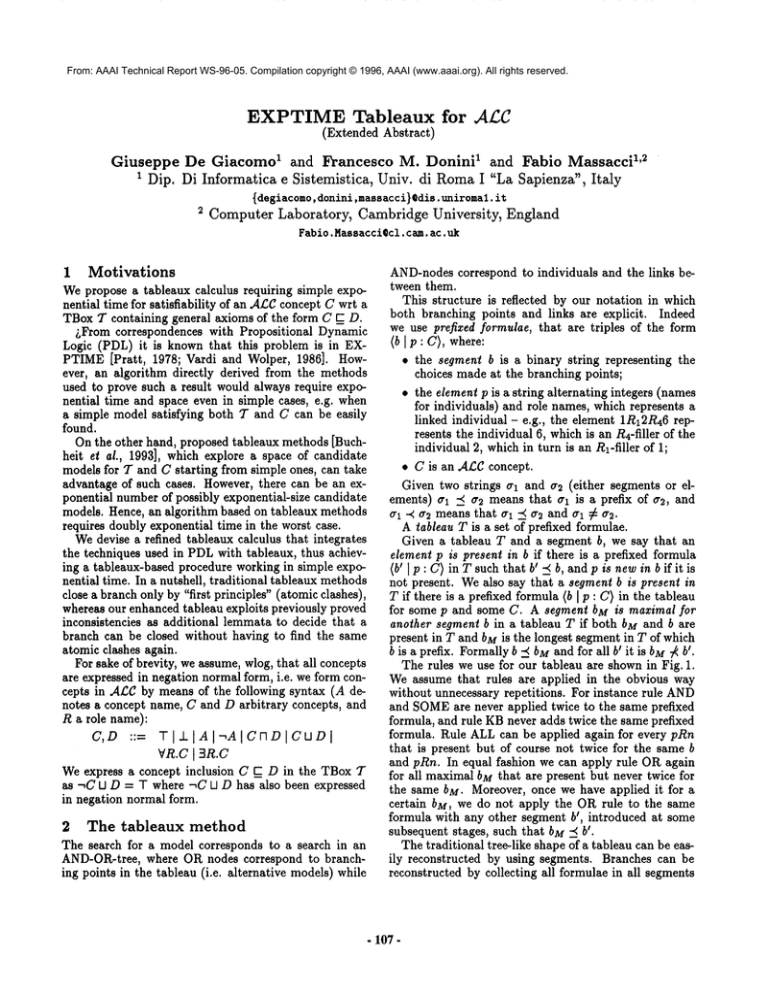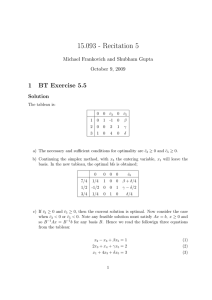
From: AAAI Technical Report WS-96-05. Compilation copyright © 1996, AAAI (www.aaai.org). All rights reserved.
EXPTIMETableaux
for A£C
(Extended Abstract)
Giuseppe
De Giacomo 1 and Francesco
M. Donini I 1,2
and Fabio
Massacci
1 Dip. Di Informatica
e Sistemistica,
Univ. di Roma I "La Sapienza", Italy
{degiacomo,
donini,massacci}@dis.
uniromal,
it
2 Computer Laboratory, Cambridge University, England
Fabio.
Massacci@cl.
cam.ac.uk
1
Motivations
Wepropose a tableaux calculus requiring simple exponential time for satisfiability of an .A£Cconcept C wrt a
TBoxT containing general axioms of the form C C D.
LFrom correspondences with Propositional Dynamic
Logic (PDL) it is known that this problem is in EXPTIME[Pratt, 1978; Vardi and Wolper, 1986]. However, an algorithm directly derived from the methods
used to prove such a result would always require exponential time and space even in simple cases, e.g. when
a simple model satisfying both T and C can be easily
found.
On the other hand, proposed tableaux methods [Buchheit et al., 1993], which explore a space of candidate
models for T and C starting from simple ones, can take
advantage of such cases. However, there can be an exponential number of possibly exponential-size candidate
models. Hence, an algorithm based on tableaux methods
requires doubly exponential time in the worst case.
Wedevise a refined tableaux calculus that integrates
the techniques used in PDLwith tableaux, thus achieving a tableaux-based procedure working in simple exponential time. In a nutshell, traditional tableaux methods
close a branch only by "first principles" (atomic clashes),
whereas our enhanced tableau exploits previously proved
inconsistencies as additional lemmata to decide that a
branch can be closed without having to find the same
atomic clashes again.
For sake of brevity, we assume, wlog, that all concepts
are expressed in negation normal form, i.e. we form concepts in .ArC by means of the following syntax (A denotes a concept name, C and D arbitrary concepts, and
R a role name):
C,D ::= T[.£[A[~A[C~D[CUD[
va.c l 3a.c
We express a concept inclusion C E D in the TBox T
as "~C tJ D = T where -~C U D has also been expressed
in negation normal form.
2 The tableaux
method
The search for a model corresponds to a search in an
AND-OR-tree, where OR nodes correspond to branching points in the tableau (i.e. alternative models) while
AND-nodescorrespond to individuals and the links between them.
This structure is reflected by our notation in which
both branching points and links are explicit. Indeed
we use prefixed formulae, that are triples of the form
(b [p : C), where:
¯ the segment b is a binary string representing the
choices made at the branching points;
¯ the element p is a string alternating integers (names
for individuals) and role names, which represents
linked individual - e.g., the element 1//12R46 represents the individual 6, which is an R4-filler of the
individual 2, which in turn is an Rl-filler of 1;
¯ C is an .A~C concept.
Given two strings ~1 and a2 (either segments or elements) ~rl _ a2 means that ~1 is a prefix of ~2, and
~1 -~ a2 meansthat ~1 ~ ~r~ and ~rl ~ ~r2.
A tableau T is a set of prefixed formulae.
Given a tableau T and a segment b, we say that an
element p is present in b if there is a prefixed formula
(b’ ] p : C) in T such that b’ ~_ b, and p is newin b if it is
not present. Wealso say that a segment b is present in
T if there is a prefixed formula (b [ p : C) in the tableau
for some p and some C. A segment bM is maximal for
another segment b in a tableau T if both bM and b are
present in T and bMis the longest segment in T of which
b is a prefix. Formallyb -~ bMand for all b’ it is I.
bM~ b
The rules we use for our tableau are shown in Fig. 1.
Weassume that rules are applied in the obvious way
without unnecessary repetitions. For instance rule AND
and SOMEare never applied twice to the same prefixed
formula, and rule KBnever adds twice the same prefixed
formula. Rule ALLcan be applied again for every pRn
that is present but of course not twice for the same b
and pRn. In equal fashion we can apply rule ORagain
for all maximal bMthat are present but never twice for
the same bM. Moreover, once we have applied it for a
certain bM, we do not apply the OR rule to the same
formula with any other segment b’, introduced at some
subsequent stages, such that bM"4 I.
b
The traditional tree-like shape of a tableau can be easily reconstructed by using segments. Branches can be
reconstructed by collecting all formulae in all segments
- 107-
¯ for some element q, with p -~ q, concept(b I q) is
&L.set and concept (b I P) # concept (b’ I P) for all
b~-<b.
AND :
OR:
What characterises a &L-set are indeed the concepts that
compose it and not the way it is constructed. Thus,
if concept (blp) is a &L-set then, obviously, all other
concept (b’ I P’) = concept(b I P) are _l_-sets too - this
a particular case of the second condition in the previous
definition.
Weenvisage for the implementation an auxiliary data
structure in which we collect all the _L-sets found at each
stage of the construction of the tableau.
with bMmaximalfor b
with pRn new
ALL:
KB :
(b I p : VR.Cl
(b [ p R n : C)
with pRn present in b
(b I P : C)
with p present in b
and C= TET.
Definition 2.2 (Closed segment) A segment b in a
tableau T is closed /f there is an element p such that
concept
(b I p)is a &L.set
forT.
Figure 1: Rules for .A£C Tableaux
sharing one given maximal segment. Branching points
are created by rule OR, where b0 corresponds to the left
branch and bl to the right one. In this case, the condition for the ORrule simply becomes "apply the ORrule
only at the leaves of a subtree, and just once for each
formula and each subtree".
A tableau T for a TBox7" and a concept C is a set of
prefixed formulae obtained by means of the rules above
starting from (0 [ 1 : C) and using 7" in the rule KB.
Given a tableau T, we call concepts of an element p
along the segment b - denoted by concept (b ] p) - the
set of concepts C such that (b’ I P : C) with ’ ~b is in
the tableau. Formally:
concept (b l P) d’d {C I <b’lp:C>¯Tandb’~b}
Wesay that an element p is a copy of an element q in
a segmentb if concept (b ] p) = concept (b’ I q) for
U. An element is reduced if no rule with the exception
of rule SOMEcan be applied to one of the formulae in
which it appears, if also rule SOMEcannot be applied
the element is fully reduced.
A segment b of a tableau T is completed if all elements
present in b are reduced, and for each element p which
is not fully reduced a fully reduced copy of p is present
in the tableau.
Definition 2.1 (Inconsistent set) Let T be a tableau.
For every segment b and every element p, we say that the
set concept (b I P) is an inconsistent set (&L-set} for T if
- inductively - one of the following conditions holds:
¯ either
&L
concept (b I P)
E
or A,-~A E concept (b I P) for some concept name
A (atomic clash);
¯ S C_ concept (b [ p) for some L-set
¯ both concept(b0 Ip) and concept(bl
sets;
Ip ) are &L-
Intuitively, a concept C is satisfiable in a TBox7" iff
there is a tableau T for 7" and C, containing a segment
b which is completed and not closed.
Whenmore rules are applicable we follow the preference criteria below, which are useful both to simplify the
proof of termination and to prove that only simple exponential time is needed in the worst ease to terminate
the search for a complete, non-closed segment.
1. Applyrules to a formula (b I P : C) only if all q ~
present in b are fully reduced.
2. Apply rule KBbefore other rules.
3. Apply rule ANDbefore rule ALL.
4. Apply rule ALLbefore rule OR.
5. Apply rule OR before rule SOME.
With this criteria we can prove the following lemma,
in which we leave implicit the reference to tableaux.
Lemma2.1 (Stability)
Let p be an element present in
a segment b. If for all formulae (b I P : C) the rule AND
has been applied, then further rule applications do not
change concept (blp) any more.
Note that by applying ORto a formula (b I P : C), we
may add formulae involving the same element p but different (longer) segments bMO,bM1. Since we apply rules
to an element p only after its predecessors q with q -~ p
have been fully reduced, it is never the ease that rule
ALLapplied to q introduces a formula involving element
p. Rule ALLmay only introduce elements of the form
prin.
To complete the construction of our tableau we only
need the conditions for termination: we do not reduce
anymore the prefixed formulae of the segment b and element p iff one of the following two conditions holds:
1. p is a copy in segmentb and concept (b I P) will not
change;
2. concept
(b I P) is a &L-set.
Note that the preference between rules we propose is
not essential; other proof strategies mayalso be devised.
However there are some minimal requirements to guarantee EXPTIMEbehaviour and termination.
- 108-
To guarantee termination it is important to check
whether concept(blp ) is not a copy before reducing
prefixed formulae of the form (b [p : 3]~.C) using rule
SOME.Our preference criteria guarantee that elements
obey the property "once a copy, always a copy". However, any other preference criteria satisfying the same
property would do. If one wants to use strategies selecting rules and formulae by some heuristics, then one
can introduce the notion of "temporary copy": check
whether concept (b I P) is a copy and freeze the reduction of these formulae; temporary copies can be reactivated when new relevant formulae are introduced.
To achieve the exponential-time
upper bound, the
strategy must guarantee the condition for termination
plus two other ones. First, it must check whether
concept (b [ p) is an already found l-set before applying
rule OR(branching) or applying rule SOME(generating
new elements) to formulae with b and p. Second, if
set concept (b I P) is found to be a L-set, then Def.2.1
must be applied and all new l-sets thus generated must
be stored for future checking.
3
Correctness
and Complexity
The correctness
and completeness
of the methodis a
simple
adaptation
of theproofs
of[Buchheit
etat.,1993].
A little
careis necessary
forclosure
of a branch
dueto
thepresence
of a l-set,
sincewediscard
a branch
before
actually
finding
an atomic
clash.
Theorem3.1 Let b be a segment in a tableau T. If an
element p is present in b such that concept (b I P) is a
L-set for T, then there is no model for b.
This can be proved by a simple induction or a "cut-andpaste" argument: each l-set is eventually generated by
the presence of some atomic clash so when we meet a lset we paste down - renaming elements - the previously
found segments with the atomic clash responsible for the
inconsistency of the set. This padding argument is then
applied in the induction step of the proof. For instance if
concept
(b I P) is a l-setbecause bothconcept
(b0l P)
andconcept
(bll P) arel-sets,
thenwe canpastebelow
b bothsegments
b0 andbl (andrecursively
forb0 andbl
if theydo notcontain
an atomic
clash)
thusobtaining
corresponding
"traditional"
closedtableau.
The proofthatthe worst-case
complexity
is indeed
optimal
is somehow
moreintricate;
wesketch
it briefly.
In the following
we denoteby n thesizeof T plus
C, whichwe assumecoincides
withthe numberof subconcepts
occurring
in 7" andC. We usec as an arbitrary
constant
(> 1).
Proposition
3.1 The size of every element present in
a segment is O(2Cn).
Indeed, there are no more that 2n sets of sub-concepts
of 7" and C. If an element is longer that 2n then it is a
copy of one of its prefixes. See [Buchheit et al., 1993].
Proposition 3.2 The size of every segment is O(2Cn).
In fact, the size of the longest segments is increased by
the application of rule OR. The number of sub-concepts
of the form C II D is at most n. Hence for each element
there are at most n possible applications of rule OR.
Since there are 0(2on) elements, the size of a segment is
O(n.2°").
Wesay that concept (b I P) is an internal l-set for T
if both the segments b0 and bl appear in T.
Proposition 3.3
Let T be a tableau. Every concept(b[p) which is an
internal L-set for T is different from any other internal
L-set concept (b’ I q)Indeed if this was not the ease, the "second detected"
would not have been an internal l-set. - as a result of
the second condition for termination.
Proposition 3.4 The number of internal
n.
tableau T is at most 2
l-sets
in a
This follows from the previous proposition and the fact
that there are at most 2n possible l-sets (since there are
2n sets of sub-concepts of 7" and C).
Proposition
3.5 The number of segments
present in a tableau T is O(2Cn).
that
are
To prove this proposition define the internal segments as
the segments b such that b0 and bl occur in T. Then the
number of internal segments is at most the numberof internal/-set,
while the number of non-internal segments
is the same as the one of internal segments.
Lemma3.2 The size of a tableau T is at most O(2en).
Indeed, the number(size) of formulae (b [ P : C) in
bounded by the number (size) of segments (O(2"n)),
number (size) of elements (O(2C")) an the number
of sub-concepts (O(n)).
As a consequence of the above lemma, we get our main
result:
Theorem 3.3 The proposed tableaux method terminates and returns an answer in simple exponential time.
4
Discussion
In this paper we have presented a tableaux calculus for
satisfiability
of a concept wrt a TBox(and hence also
for subsumption in a TBox) which works in worst-case
exponential time. In fact we do not need to change substantially the "normal" construction used by tableaux
which has proven to be reasonably effective in practice
[Bresciani et al., 1995]. The key point is to make use
of an auxiliary data structure which is used store sets
of concepts whose conjunction was already proved to be
inconsistent.
Our main ideas behind our procedure can be used to
device EXPTIMEtableaux procedures for various extension of A£C. In particular, our calculus can be easily
modified to deal with an ABoxas well.
- 109-
References
[Bresciani et al., 1995] P. Bresciani, E. Franconi, and
S. Tessaris. Implementing and testing expressive description logics: Preliminary report. In Alexander
Borgida, Maurizio Lenzerini, Daniele Nardi, and Bernhard Nebel, editors, Working Notes of the 1995 Description Logics Workshop, Technical Report, RAP
07.95, Dipartimento di Informatica e Sistemistica,
Universit~ di Roma"La Sapienza", pages 131-139,
Rome(Italy), 1995.
[Buehheit et al., 1993] Martin Buchheit, Francesco M.
Donini, and Andrea Schaerf. Decidable reasoning
in terminological knowledge representation systems.
Journal of Artificial Intelligence Research, 1:109-138,
1993.
[Pratt, 1978] V. R. Pratt. A practical decision method
for propositional dynamic logic. In Proceedings of
the Tenth A CMSymposium on Theory of Computing
(STOC-78), pages 326-337, 1978.
[Vardi and Wolper, 1986] Moshe Y. Vardi and Pierre
Wolper. Automat~-theoretic techniques for modal logics of programs. Journal of Computer and System
Sciences, 32:183-221, 1986. A preliminary version appeared in Proc. of the 16th ACMSIGACTSyrup. on
Theory of Computing (STOC-84).
- 110-






